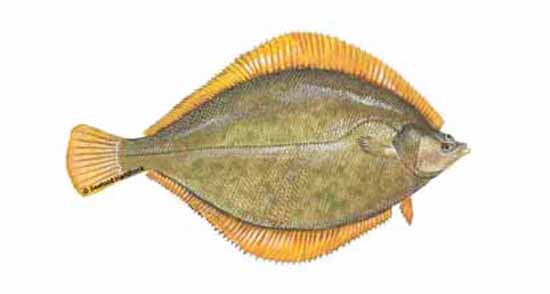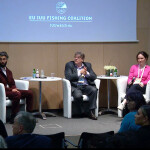Flounder
Published on
January 23, 2014

Around 540 flatfish species belong to the taxonomic order Pleuronectiformes, meaning “sideswimmer.” Flatfish are found throughout the world, though the most commercially important family, Plueronectidae, is concentrated in northern waters. Yellowtail is the most important Atlantic Coast flounder, and petrale sole is the most important West Coast species. Flatfish have both eyes on one side of the head, though they begin life as normal fish. As they become bottom dwellers, one eye migrates to the other side, resulting in “right-eyed” and “left-eyed” flatfish. Soles and flounders harvested commercially in North America are right-eyed, except fluke. Flounder fillets vary in shape, depending on the species. Gray sole offers long, slender fillets; yellowtail flounder, rock sole, lemon sole, fluke and dab offer thicker, broader fillets.
Pleuronectes spp; Microstomus pacificus; Eopsetta jordani; Glyptocephalus cygnoglossus; Paralichthys dentatus
Flounder, sole
Rock sole, yellowtail flounder, sand dab, yellowfin sole, dab; Dover sole, Alaska Dover, American Dover; petrale sole, California sole; gray sole, lemon sole, witch flounder; summer flounder, plaice Northern fluke
Pleuronectidés
Scholle
Pleuronectidi
Akagarei
Platija Americana
Around 540 flatfish species belong to the taxonomic order Pleuronectiformes, meaning “sideswimmer.” Flatfish are found throughout the world, though the most commercially important family, Plueronectidae, is concentrated in northern waters. Yellowtail is the most important Atlantic Coast flounder, and petrale sole is the most important West Coast species. Flatfish have both eyes on one side of the head, though they begin life as normal fish. As they become bottom dwellers, one eye migrates to the other side, resulting in “right-eyed” and “left-eyed” flatfish. Soles and flounders harvested commercially in North America are right-eyed, except fluke. Flounder fillets vary in shape, depending on the species. Gray sole offers long, slender fillets; yellowtail flounder, rock sole, lemon sole, fluke and dab offer thicker, broader fillets.
Raw flounder ranges from tan to pinkish to snow white, but cooked meat of all species is pure white, lean, boneless and flaky with a mild flavor, ranging from bland to sweet. Taste and texture vary, depending on species. Petrale sole, with firm, delicate-tasting flesh, is considered the premier Pacific sole. Pacific Dover, with softer flesh, is a lesser-quality product. Cooked meat of smaller soles and flounders is delicate, while larger species like fluke or dab are firm and meaty.The sweet taste and firm texture of yellowtail flounder is often regarded as the standard to which other flounders are compared. Lemon and gray sole aren’t far behind.
| Calories: | 91 |
| Fat Calories: | 10.8 |
| Total Fat: | 1.2 g |
| Saturated Fat: | 0.3 g |
| Cholesterol: | 48 mg |
| Sodium: | 81 mg |
| Protein: | 18.8 g |
| Omega 3: | 0.2 g |
Use wine, sauce, other liquids or moist vegetables to keep thin flatfish fillets from drying out. Avoid sauces and herbs that overpower their delicate taste. Thicker fillets are great for broiling, served with lightly herbed butter. The firm and meaty flesh of larger species like fluke or dab is good for rolling or stuffing. Small H&G sole — like rex or gray — can be grilled, baked or stuffed, but not filleted, because fillets would be too small.
Other thin whitefish fillets
- Bake
- Boil
- Broil
- Fry
- Grill
- Pate
- Poach
- Saute
- Smoke
- Steam
[
Fresh: Whole, Dressed (head on, boneless), H&G, Fillets
,Frozen: Whole, Dressed (head on), H&G, Fillets, Blocks (mainly yellowfin fillets)
,Value-added: Breaded/battered portions, Whole (stuffed), Smoked
]Canada, Iceland, Norway, Russia, UK, United States





